Hands On with ASUS ROG Avalon: A Teardown Video
by Ian Cutress on September 2, 2016 7:00 AM EST- Posted in
- desktops
- Systems
- Motherboards
- Asus
- ROG
- Trade Shows
- Computex_2016
- Video
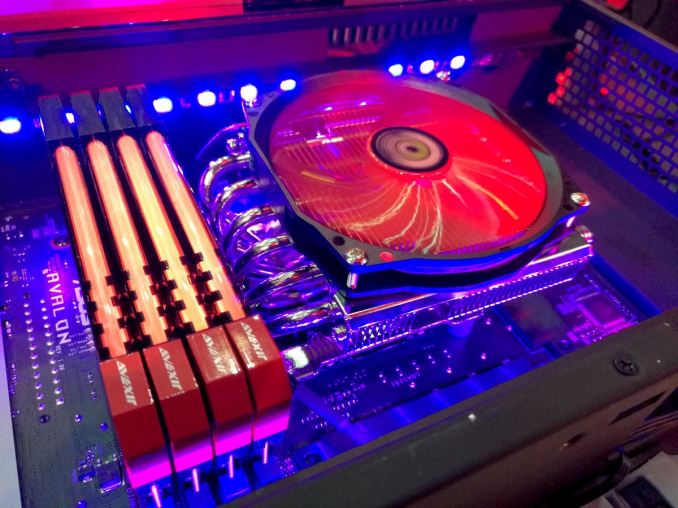
During Computex 2016, as part of their 10-Years of the Republic of Gamers’ celebrations and showcase, ASUS surprised me with a new take on the PC: the ROG Avalon. The Avalon is still a very extensive work in progress, however the fundamental concept is highly intriguing for anyone interested in PC design – using custom form factor parts and fitting them into a dedicated chassis but still opening up the options for users to customize their build. We were able to grab the hardware and Johnathan Chu, Product Manager for motherboards at ASUS, for a short time to record a video for a quick teardown and analysis.
Apologies for the audio, it was an impromptu recording with no equipment apart from a smartphone.
Project Avalon
Section taken from our Computex 2016 Coverage
When you’ve been reviewing and testing motherboards, as well as shouting at certain engineers for absolutely nonsense ideas (or really good ones), there is somewhat a monotony to it all. One generation there’s a new feature from one manufacturer, and the next generation we see it on mostly all the others. Some features are special and aren’t copied, but these require larger amounts of R&D and investment, then require the PR teams to communicate why the new feature is good or not.
One interesting conversation I had a couple of years ago was regarding the future of motherboard form factors. It was then as we see now: the full sized ATX, micro-ATX and mini-ITX systems accounted for 99%+ of desktop class PCs. Some large OEMs had their own designs on desktops, Zotac has a number of small mini-PCs for various markets, and servers do all sorts of standard and non-standard sizes, but for the consumer, it is essentially all about those three (and mini-STX is now moving in that space). So a couple of years ago, when the initial talk of Steam machines was coming to play, ASUS asked me what I thought about non-standard motherboard sizes in desktop sized systems.
It should be clear to most that the motherboard size issue is a chicken/egg situation. When Intel designs a CPU, there are certain limitations to where everything should go. Or no, I will correct that – there’s a budget limitation to where things can go. For example, memory is often to a certain side of the CPU because that provides the best quality signal for the onboard traces. Technically it can go on a different side (as it does on some designs), but that often requires more motherboard PCB layers to ensure the signal does not degrade or interfere with other signals, and in most cases there is a performance/latency penalty if you have to put it further away. But in order to stay buoyant, a motherboard manufacturer will stick to the appropriate design, because guess what – all the cases use the same standards too. The minute you produce a novel motherboard design, such as a different IO position or a new method for storage, none of the current cases on the market will work with it. So the case manufacturers can’t change because there are no products in a new design, the motherboard manufacturers can’t change because of the lack of cases but also the cost, and Intel keeps it consistent to keep everyone in the chain happy. Hello chicken, meet egg. Hello egg, meet chicken.
The only way to do a custom form factor is to build the system completely yourself, which is what Zotac does. Zotac plays mainly in the mini-PC market, and their owner Partner (‘Manufacturer of motherboards, AGP cards and other consumer electronics’ on their Google Search) has long fingers into manufacturing for other big name brands, so integrating the Zotac brand into new designs with custom chassis is easy enough. However ASUS wanted to go bigger and better, and that is how systems like the G20, a full desktop with a custom design, and the GR8, a book-sized Steam machine, came about. But it was clear, ASUS wanted more. Insert Project Avalon.
Project Avalon
Project Avalon is a custom, high-performance, gaming/VR PC design from ASUS. It is still very early in the design cycle, to the extent that this chassis currently weighs almost 40 lbs, but the concept is there. Inside is a custom designed motherboard that uses various internal connectors to implement various features. The design as it stands is built for Skylake plus a single GPU, and enough space to operate liquid cooling. The Perspex window on the top is so users can see into the design, flashing lights and all.
Astute readers will note that the PCB design looks rather odd – there isn’t a PCIe slot here, no power delivery, no rear IO, and what looks like the rear of a 24-pin power connector on the left-hand side. All we needed to do was take the motherboard out:
On the top we have a CPU socket, some memory slots, an M.2 slot, and what looks like a number of connectors for daughter boards. If we flip it over:
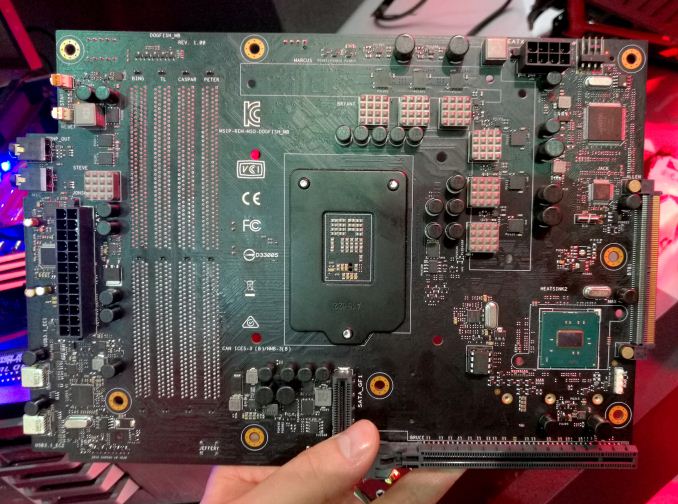
Click the image for the full resolution
Here we see more of what we know – power delivery chokes, a chipset, an 8-pin CPU power connector, a PCIe x16 connector and a 24-pin power connector. There are no SATA ports, and nothing on this system looks normal.
So, to explain: on the bottom near my finger is a custom connector, akin to a 4x PCIe connector, that breaks out into four SATA ports on a daughter board where are hot swappable on the chassis. The connector supplies both data and power. On the far right is a proprietary ASUS header for the rear IO.
At current, ASUS is not finalized on the pin layout and isn’t conforming to any particular standard, but this connector can send chipset PCIe lanes, digital video, and a few other things, over to a daughter board. This means one thing – adjustable rear IO panels!
I love this idea. Here are two examples of what ASUS suggests: the top one is a rear IO for workstation users, featuring dual Intel NIC and inside is a RAID capable M.2 slot running at PCIe 3.0 x4. The rear panel is a Home Theater focused design, using a single NIC and a USB 3.1 controller for 10 Gbps use. ASUS also had a VR edition with the specific ports required for the big VR headsets currently in the market. Because the custom connector carries enough PCIe, this opens it up to other custom designs, such as Thunderbolt, 10 Gbit Ethernet, different Ethernet/WiFi, additional storage, or anything that needs PCIe. Also, on the audio side, because this is a separate board, it could also influence audio capabilities and provide cleaner signals for audio processing. Adjustable rear IO is a topic only just being breached, with plenty of possibility.
Avalon's design is still very much fluid, with single GPU setups currently being supported:
In the video at the top of the page, we were able to get some hands-on time with Jonathan Chu, the product manager of Avalon, and do a quick teardown video after Computex had finished. Apologies for the audio, it was an impromptu recording with no extra equipment apart from a smartphone.
At this point the Avalon project is in an early design phase, so ASUS is looking for feedback with what they have so far. I don’t particularly mind if this ends up being an engineering concept design that never goes on sale (I’ve been pushing manufacturers to do more concept designs, similar to vehicle manufacturers at car shows), but the fact that ASUS are prepared to even attempt this is a good thing.


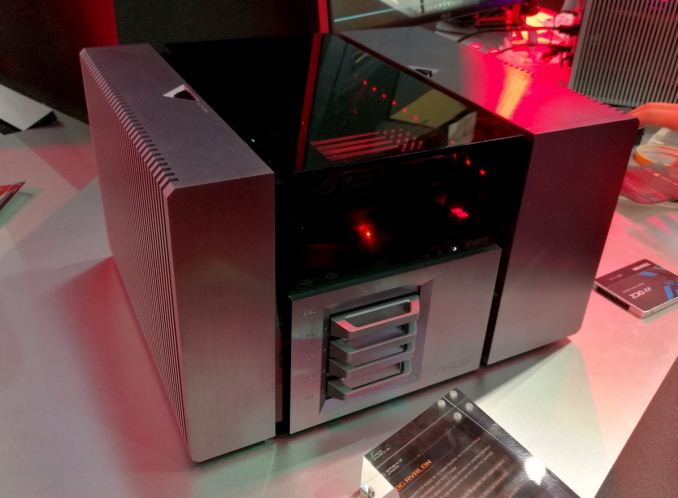
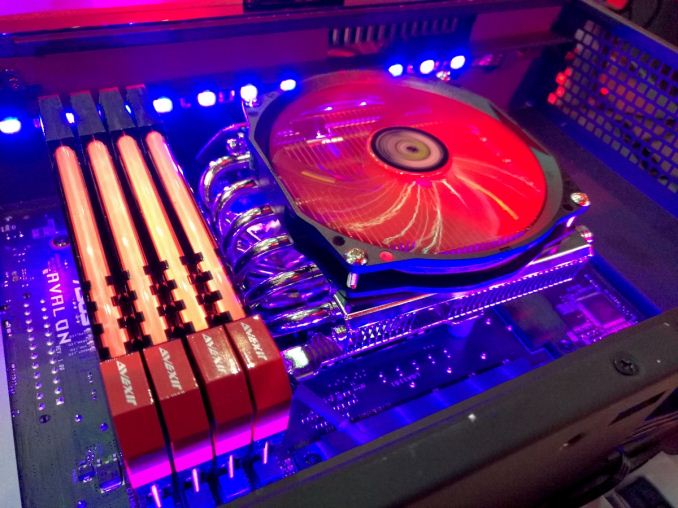
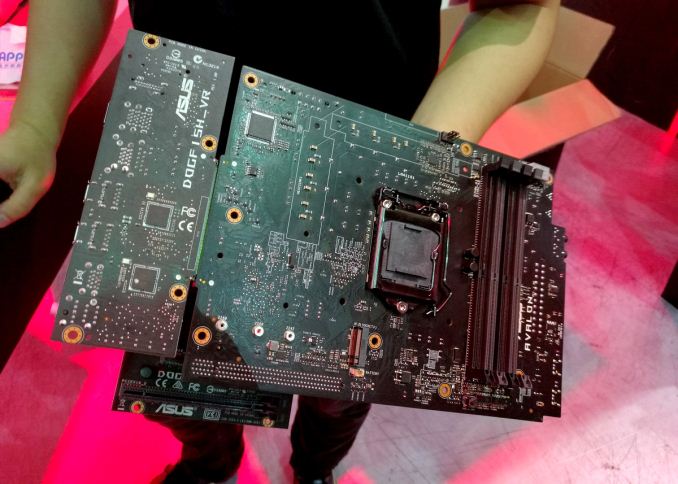

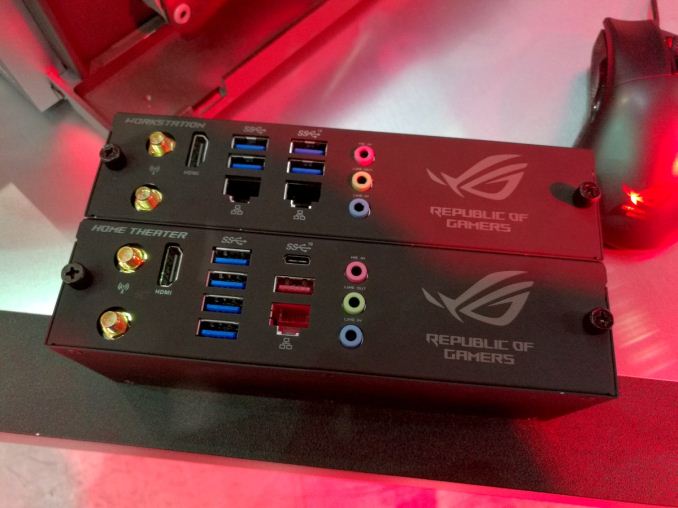
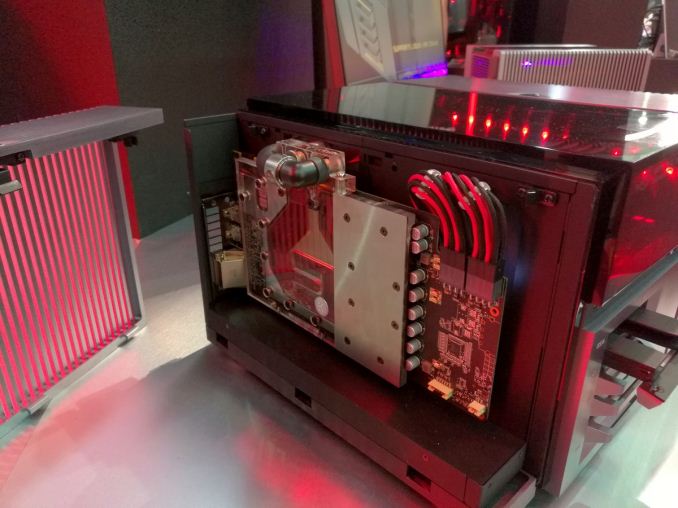








41 Comments
View All Comments
Exodite - Friday, September 2, 2016 - link
Everything comes full circle eventually, with the PC market being stagnant and people not generally upgrading components individually this was inevitable.Is it funny that the first though in my mind were the Amiga 3000/4000 with the modular daughterboards?
Mondozai - Monday, September 12, 2016 - link
PC market being stagnant? Gaming GPUs are increasing YoY quite a bit. (Overall GPU sales are down from 2011, but that is because a lot of those GPUs were simply entry-level GPUs not used for gaming).Remember, we're talking about ROG here. That is a gaming brand. So gaming sales are what counts. Gaming sales in the PC space are not stagnant, you're talking out of your ass.
HOOfan 1 - Friday, September 2, 2016 - link
This thing would look right at home in an early 1980s stereo setupfteoath64 - Monday, September 5, 2016 - link
Yeah a retro look at this day and age would be very much appropriate since your standard motherboard has been around for decades. The "rear IO" part looks interesting breaking out into SLI for PCIE X16 slots would be needed on the GPU side rather than a daughter-card layout.CaedenV - Friday, September 2, 2016 - link
That is cute!One bit of feedback;
No home theater person is going consider that home theater backplane. There are 3 options for audio output: Through the video card piggybacking on the HDMI/DP output, via optical, or with old-school analog jacks. I assume that the piggyback option is available, but the lack of optical or surround analog is an instant deal breaker for many.
Also, why not make the front drive bay modular like the rear IO area? Again, for a home theater/home server design there would still be lots of call for traditional HDDs, and it looks like you could pretty easily cram 4 HDDs and 2 SSDs up there if you really wanted to. The ability to swap the whole cage out for whatever drive config you need at the moment would be rather useful.
Outside of that, it seems like a really great idea! Keep working on it!
namechamps - Saturday, September 3, 2016 - link
I don't think the lack of optical or analog is a huge issue. Honestly once you have a HDMI capable receiver there is no point to mess with those inferior options.Sushisamurai - Sunday, September 4, 2016 - link
I think a lack of optical or analog is a huge deal breaker for any home theater setup - unless you constantly change your receivers to match display technology, your HDMI receivers are going to get outdated quick for HDCP streaming, or you would need enough HDMI ports. My current home theater setup with my projector is direct display connection to the comp, with an optical out to the receiver, as the projector doesn't handle audio out to receiver well - receiver is also out of HDMI ports.Sushisamurai - Sunday, September 4, 2016 - link
I understand that current recievers have 6-8 HDMI inputs, but older ones can be populated relatively quickly (3 to 5):1. Blu-ray
2. Chromecast/AppleTV
3. Xbox
4. PS3/4
5. Computer
I assume most home setups have this configuration.
drgigolo - Monday, September 5, 2016 - link
I think you are very wrong in this. I haven't heard of anybody who doesn't use HDMI directly. If you run out of HDMI ports on your receiver, you can always hook it up directly to the TV and then use optical from the TV to the receiver.Analog from your computer to your hifi sucks most of the time. A lot of interference and cables that cause problems. It's best to get the digital to analog conversion as far away from the computer as possible in my experience.
vacavalier - Saturday, September 24, 2016 - link
Not true... Using a SB ZxR PCI-e sound card w/Analog Monster cables from my PC direct to my Onkyo TX-NR809 and running the sound through two Klipsch RB-81 II's (bi-wired w/12 ga.wire) and a Klipsch 12RW-D and the sound and imaging (both iTunes and gaming) is simply incredible....No sound effects are applied through or by the AVR and this setup simply destroys any plug-n-play speaker setups, regardless of price-point, name-brand, features, etc. on the market today.
Once funds allow, the Onkyo will either be: upgraded to a higher quality integrated amp, power & pre-amp duo or add an analog/tube power amp to it.
I know sound quality is subjective to the listener but honestly, I tried this same setup using the onboard Realtek sound "chip" (because that is what it is) and the sound "sucked" as you stated. A higher quality soundcard must be employed to achieve the desired effect and on that note, one where the op-amps can be swapped to further upgrade/sweeten the sound.
Just my opinion here concerning what hardware is involved, concerning analog sound.